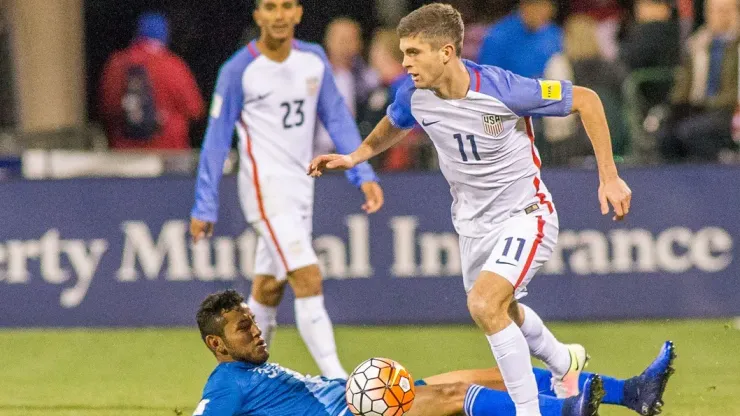The “next big thing” has been a US soccer mantra for players going back to Jovan Kirovski’s time at Manchester United two decades ago. Time and again, American soccer fans and the media have hyped teenage players. First, it was Kirovski, then it was John O’Brien — a great whose career was curtailed by injuries. Then there were an assembly line of players who were hyped to succeed including Jamar Beasley (whose brother DaMarcus actually turned into a bonafide star while he ended up spending most of his career playing indoor soccer), Landon Donovan — who did pan out — Freddy Adu, whose odyssey ushered in an era where every hyped young American player ended up underwhelming. Added to this list are Jozy Altidore, Charles Renken, Juan Agudelo and Joseph Gyau. Only Altidore ever became a regular for the US Men’s National Team. But at the club level, with the exception of one season in the Netherlands, the hype never matched his output either in Europe or even at home in MLS.
So it would be natural for most observers to be skeptical of the current poster child for prodigal American talent – Christian Pulisic. At 17 years of age, Pulisic has already been capped for the senior US Men’s National Team, and been elevated to the first team at Bundesliga giants Borussia Dortmund.
American fans have a habit not unlike those in other nations but perhaps more loudly and reflexively to hail anything that appears positive for a young player. But in Pulisic’s case, the hype might finally be justified.
Like many other young Americans who draw interest at a young age from top European clubs, Pulisic became a curiosity to those in the American soccer media who cover the youth national teams and Americans abroad. But unlike most of the other youngsters that have gravitated to Europe, Pulisic has actually been garnering the attention of the more critical German and British press for about nine months now. A standout at the youth level for Dortmund, it was still surprising that when an injury crisis hit the Bundesliga club, which sits safely in second place in the league, that Pulisic was called into the first team.
SEE MORE: Read Kartik’s new book, ‘Soccerwarz: Inside America’s soccer feud between MLS, NASL and USL
Given an opportunity to impress with Thomas Tuchel’s side, the young Hershey, PA native did not disappoint and is now a full fledged first-team member. Pulisic has already earned more plaudits and played in more meaningful games than many American youngsters who are three or four years older than him.
But that alone is not what makes Pulisic such an amazing youngster for the United States and different from the others. His vision, his touch and his ability to find pockets of space against defenses that are bunkered are traits that so many Americans even with years of professional experience lack. He also, much like many American players of the recent past, is an effective counter-attacking force in wide areas.
Routinely, Pulisic has come on late in games for Dortmund when the opposition has been bunkered in its own half, looking to see out a draw or an unlikely win. In these late game appearances, he has been able to showcase both his skills against well-organized defenses and in more open free-flowing games as a counter-attacking threat.
One such instance of Pulisic demonstrating both traits in a big game was less than two weeks ago when Dortmund faced relegation-threatened Werder Bremen at Signal Iduana Park. Pulisic was brought on in minute 80 for Dortmund captain Marco Reus with the game deadlocked at 2-2. Bremen was defending deep, holding out for a draw with eight men behind the ball. Pulisic immediately found a pocket of space on the right flank and exploited it. Beating a defender in a one-on-one matchup, the ball was eventually cleared for a corner. This corner led directly to Adrian Ramos’ winner in minute 82. Following this, with Bremen forced to push men forward, Pulisic repeatedly looked dangerous as a counter-attacking threat, allowing Dortmund to kill valuable time en-route to sealing a 3-2 victory, which at the time kept them just five points behind first-placed Bayern in the Bundesliga table.
The United States Men’s National Team has, through the last few years, had difficulty finding attacking players good enough on the ball in tight spaces and incisive enough to find areas with which to make diagonal runs. Pulisic has already demonstrated he’s picked up these traits at a very high level. While American fans might be obsessive about finding the next great striker who can bang in goals, an attacking player like Pulisic could be critical to the national team, recovering much of the ground it has lost in the global game over the past several years.
While critics remain justifiably skeptical given the poor track record of hyped-American youngsters in recent years, Pulisic is different. The Dortmund man’s qualities and the displays he has already put in at Dortmund make Pulisic different to just about any player that has emerged in the US player pool in the last decade.
200+ Channels With Sports & News
- Starting price: $33/mo. for fubo Latino Package
- Watch Premier League, Women’s World Cup, Euro 2024 & Gold Cup
The New Home of MLS
- Price: $14.99/mo. for MLS Season Pass
- Watch every MLS game including playoffs & Leagues Cup
Many Sports & ESPN Originals
- Price: $10.99/mo. (or get ESPN+, Hulu & Disney+ for $14.99/mo.)
- Features Bundesliga, LaLiga, Championship, & FA Cup
2,000+ soccer games per year
- Price: $5.99/mo
- Features Champions League, Serie A, Europa League & Brasileirāo
175 Premier League Games & PL TV
- Starting price: $5.99/mo. for Peacock Premium
- Watch 175 exclusive EPL games per season







